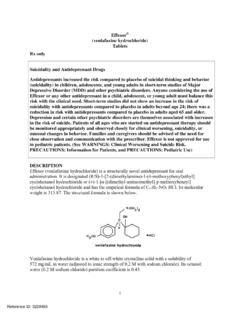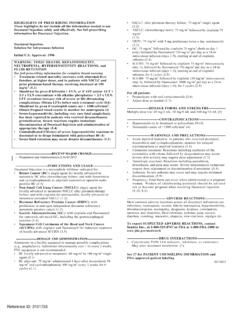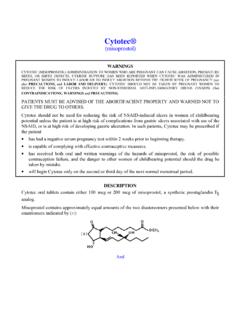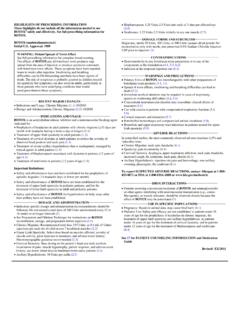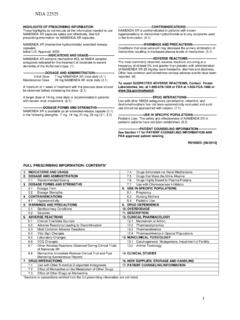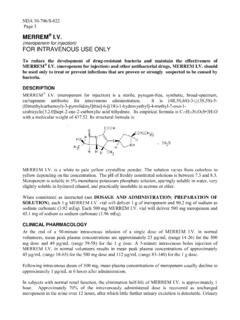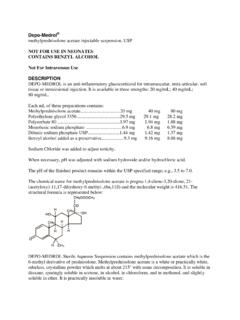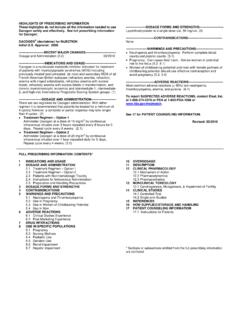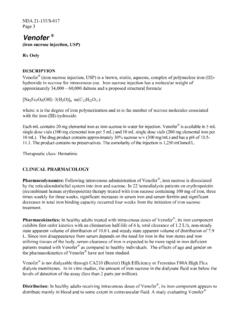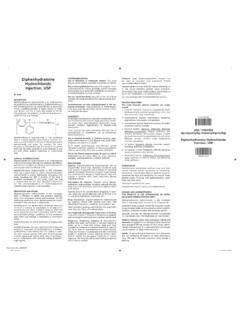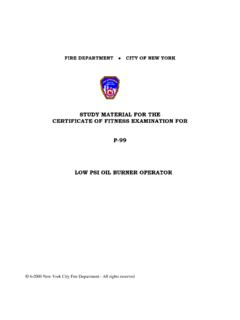Transcription of NOVANTRONE mitoXANTRONE for injection concentrate …
1 NOVANTRONE mitoXANTRONE for injection concentrate WARNING NOVANTRONE ( mitoXANTRONE for injection concentrate ) should be administered under the supervision of a physician experienced in the use of cytotoxic chemotherapy agents. NOVANTRONE should be given slowly into a freely flowing intravenous infusion. It must never be given subcutaneously, intramuscularly, or intra-arterially. Severe local tissue damage may occur if there is extravasation during administration. (See ADVERSE REACTIONS, General, Cutaneous and DOSAGE AND ADMINISTRATION, Preparation and Administration Precautions).
2 NOT FOR INTRATHECAL USE. Severe injury with permanent sequelae can result from intrathecal administration. (See warnings , General) Except for the treatment of acute nonlymphocytic leukemia, NOVANTRONE therapy generally should not be given to patients with baseline neutrophil counts of less than 1,500 cells/mm3. In order to monitor the occurrence of bone marrow suppression, primarily neutropenia, which may be severe and result in infection, it is recommended that frequent peripheral blood cell counts be performed on all patients receiving NOVANTRONE . Cardiotoxicity: Congestive heart failure (CHF), potentially fatal, may occur either during therapy with NOVANTRONE or months to years after termination of therapy.
3 Cardiotoxicity risk increases with cumulative NOVANTRONE dose and may occur whether or not cardiac risk factors are present. Presence or history of cardiovascular disease, radiotherapy to the mediastinal/pericardial area, previous therapy with other anthracyclines or anthracenediones, or use of other cardiotoxic drugs may increase this risk. In cancer patients, the risk of symptomatic CHF was estimated to be for patients receiving up Reference ID: 3105100 to a cumulative dose of 140 mg/m2. To mitigate the cardiotoxicity risk with NOVANTRONE , prescribers should consider the following: All Patients: - All patients should be assessed for cardiac signs and symptoms by history, physical examination, and ECG prior to start of NOVANTRONE therapy.
4 - All patients should have baseline quantitative evaluation of left ventricular ejection fraction (LVEF) using appropriate methodology (ex. Echocardiogram, multi-gated radionuclide angiography (MUGA), MRI, etc.). Multiple Sclerosis Patients: - MS patients with a baseline LVEF below the lower limit of normal should not be treated with NOVANTRONE . - MS patients should be assessed for cardiac signs and symptoms by history, physical examination and ECG prior to each dose. - MS patients should undergo quantitative reevaluation of LVEF prior to each dose using the same methodology that was used to assess baseline LVEF. Additional doses of NOVANTRONE should not be administered to multiple sclerosis patients who have experienced either a drop in LVEF to below the lower limit of normal or a clinically significant reduction in LVEF during NOVANTRONE therapy.
5 - MS patients should not receive a cumulative NOVANTRONE dose greater than 140 mg/m2. - MS patients should undergo yearly quantitative LVEF evaluation after stopping NOVANTRONE to monitor for late occurring cardiotoxicity. Secondary Leukemia: NOVANTRONE therapy in patients with MS and in patients with cancer increases the risk of developing secondary acute myeloid leukemia. Reference ID: 3105100 NHCH 2CH2 NHCH 2CH2OH . 2 HCl NHCH 2CH2 NHCH 2CH2OH OH O OH O For additional information, see warnings and DOSAGE AND ADMINISTRATION. DESCRIPTION NOVANTRONE ( mitoXANTRONE hydrochloride) is a synthetic antineoplastic anthracenedione for intravenous use.
6 The molecular formula is C22H28N4O6 2 HCl and the molecular weight is It is supplied as a concentrate that MUST BE DILUTED PRIOR TO injection . The concentrate is a sterile, nonpyrogenic, dark blue aqueous solution containing mitoXANTRONE hydrochloride equivalent to 2 mg/mL mitoXANTRONE free base, with sodium chloride ( w/v), sodium acetate ( w/v), and acetic acid ( w/v) as inactive ingredients. The solution has a pH of to and contains mEq of sodium per mL. The product does not contain preservatives. The chemical name is 1,4-dihydroxy-5,8-bis[[2-[(2-hydroxyethy l) amino]ethyl]amino]-9,10 anthracenedione dihydrochloride and the structural formula is: CLINICAL PHARMACOLOGY Mechanism of Action mitoXANTRONE , a DNA-reactive agent that intercalates into deoxyribonucleic acid (DNA) through hydrogen bonding, causes crosslinks and strand breaks.
7 mitoXANTRONE also interferes with ribonucleic acid (RNA) and is a potent inhibitor of topoisomerase II, an enzyme responsible for uncoiling and repairing damaged DNA. It has a cytocidal effect Reference ID: 3105100 on both proliferating and nonproliferating cultured human cells, suggesting lack of cell cycle phase specificity. NOVANTRONE has been shown in vitro to inhibit B cell, T cell, and macrophage proliferation and impair antigen presentation, as well as the secretion of interferon gamma, TNF , and IL-2. Pharmacokinetics Pharmacokinetics of mitoXANTRONE in patients following a single intravenous administration of NOVANTRONE can be characterized by a three-compartment model.
8 The mean alpha half-life of mitoXANTRONE is 6 to 12 minutes, the mean beta half-life is to hours and the mean gamma (terminal or elimination) half-life is 23 to 215 hours (median approximately 75 hours). Pharmacokinetic studies have not been performed in humans receiving multiple daily dosing. Distribution to tissues is extensive: steady-state volume of distribution exceeds 1,000 L/m2. Tissue concentrations of mitoXANTRONE appear to exceed those in the blood during the terminal elimination phase. In the healthy monkey, distribution to brain, spinal cord, eye, and spinal fluid is low. In patients administered 15-90 mg/m2 of NOVANTRONE intravenously, there is a linear relationship between dose and the area under the concentration-time curve (AUC).
9 mitoXANTRONE is 78% bound to plasma proteins in the observed concentration range of 26 455 ng/mL. This binding is independent of concentration and is not affected by the presence of phenytoin, doxorubicin, methotrexate, prednisone, prednisolone, heparin, or aspirin. Metabolism and Elimination mitoXANTRONE is excreted in urine and feces as either unchanged drug or as inactive metabolites. In human studies, 11% and 25% of the dose were recovered in urine and feces, respectively, as either parent drug or metabolite during the 5-day period following drug administration. Of the material recovered in urine, 65% was unchanged drug. The remaining 35% was composed of monocarboxylic and dicarboxylic acid derivatives and Reference ID: 3105100 their glucuronide conjugates.
10 The pathways leading to the metabolism of NOVANTRONE have not been elucidated. Special Populations Gender The effect of gender on mitoXANTRONE pharmacokinetics is unknown. Geriatric In elderly patients with breast cancer, the systemic mitoXANTRONE clearance was L/hr/m2, compared with L/hr/m2 and L/hr/m2 for non-elderly patients with nasopharyngeal carcinoma and malignant lymphoma, respectively. Pediatric mitoXANTRONE pharmacokinetics in the pediatric population are unknown. Race The effect of race on mitoXANTRONE pharmacokinetics is unknown. Renal Impairment mitoXANTRONE pharmacokinetics in patients with renal impairment are unknown.
